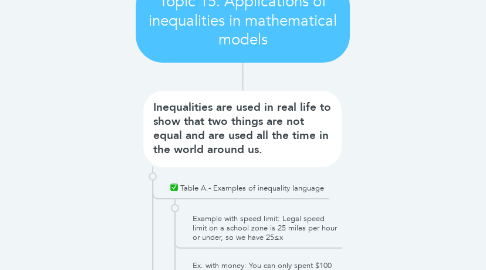
1. Inequalities are used in real life to show that two things are not equal and are used all the time in the world around us.
1.1. Table A.- Examples of inequality language
1.1.1. Example with speed limit: Legal speed limit on a school zone is 25 miles per hour or under, so we have 25≤x
1.1.2. Ex. with money: You can only spent $100 or less at the store. So we have x≤100
1.1.3. Now with profits: You should sell at least 10 products in order to obtain profit. So this is represented by x≥10
1.2. Table B.- Inequality common key words.
1.2.1. If we say "At least" that means greater than or equal to (≥).
1.2.2. If we say "No more than, at most" that means less than or equal to to (≤).
1.2.3. If we say "More than" that means greater than to (>).
1.2.4. If we say "Less than" that means less than (<).
1.3. Table C.- Solving a real-life inequality problem.
1.3.1. Step 1: Label the variable.
1.3.2. Step 2: Write an inequality that models the situation.
1.3.3. Step 3: Make sure you include in the model all the information given and express the inequality in standard form.
1.3.4. Step 4: Solve the quadratic inequality following one of the 3 different methods described in the Lesson 14.
1.3.5. Step 5: Interpret the result.
1.3.6. Step 6: Verify that the result satisfies the inequality model.
